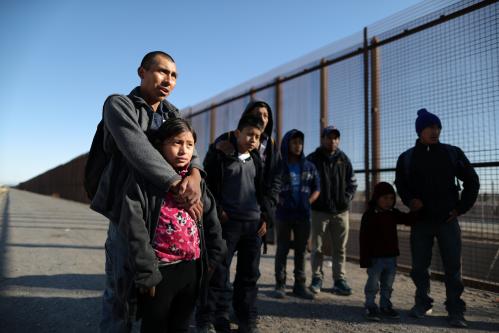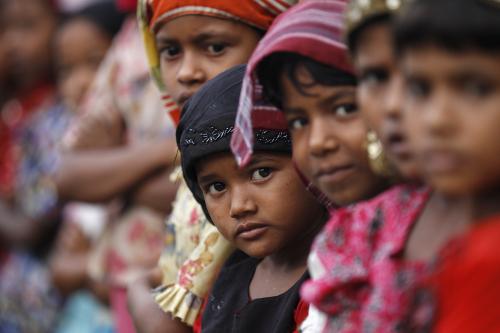Arbitrary displacement as a consequence of violence or threats thereof, ethnic persecution or cleansing, as well as displacement as a consequence of natural disasters, is not just a passing event in people’s lives. Rather, displacement means that, from one day to the next, families lose their homes and livelihoods, leaving behind all they had cherished. It is a remarkable, and devastating, transformation. Too often, displacement implies that children lose their access to education and may be forced into child labour, sexual exploitation or recruitment into armed groups. Their own, as well as their parents’ dreams for a better future, vanish overnight. All too often communities break apart under the stress of displacement, resulting in marginalization, sexual and gender-based violence or exploitation of children, loss of community, culture and tradition, and so on. In short: internal displacement shatters lives. Not surprisingly, it takes a long time to rebuild them.
This is particularly true where internal displacement lasts not just a few months or years but becomes protracted over a period of five, ten, fifteen and more years, and all the while, the affected persons linger in camps, welfare centres, and with host families, without having the possibility to lead normal lives on their own. Not willing to give up dreams of return, yet unable to do so, often IDPs live in a sort of suspended reality, with no clear path ahead.
Such are the situations we are addressing during these three days of the National Consultation on the Status of Internally Displaced Persons within the Framework for Durable Solutions. This consultation is timely regardless of the present situation in your country and the difficulties in the north. While not forgetting the suffering and the great needs of civilians now caught up in the conflict, we should welcome this opportunity offered to us today to look to the future. For all, whether they have been displaced recently or have been displaced since the 1990s, durable solutions must be found — a challenge that requires advanced thought and planning. We should do everything possible to avoid having the recently displaced end up in protracted displacement and this Consultation may contribute to this goal. In short, we should look at durable solutions as comprehensively as possible and not limit ourselves to one particular group.
In my capacity as Representative of the UN Secretary General on the Human Rights of Internally Displaced Persons, it is a particular pleasure for me to be with you today. When I came to Sri Lanka on an official mission in December 2007, I reviewed the recent displacements in the east and the north of the country. But I also felt it imperative to address the fate of the roughly 300,000 persons in protracted displacement, i.e., the communities in Jaffna, Mannar, Puttalam and Vavuniya who fled their villages and homes due to the conflict six to seventeen years ago. Their displacement no longer seems sensational; as a consequence, their fate is often forgotten. To make the point, the first area I visited was Puttalam.
I also looked into the situation of those who were in the process of returning in the east and found that while progress had been made, even for those who had returned home, significant obstacles remained, precluding their return to normal lives. A very substantial part of my mission report was dedicated to the issue of finding durable solutions. In fact, one of the lasting impressions I carry from this mission is how passionately, and uniformly all of the IDPs I met expressed their desire to lead their lives in normalcy again — in other words, in safety and security, with access to livelihoods and basic services.
In my conclusions and recommendations, I reiterated my desire to continue my dialogue with the Government, and specifically, to cooperate in the search for durable and equitable solutions for all of Sri Lanka’s IDPs. At the debriefing, I mentioned the possibility of a national workshop on durable solutions to Hon. Minister Samarasinghe, as well as my readiness to participate. I am very happy to see that only nine months later, thanks to the dedication and strong leadership of the Minister, this suggestion has become a reality. Hon. Minister Bathiudeen stressed to me the shameful conditions in which the Muslim IDPs have lived for such a long time, and the responsibility of the government to end this situation. His words, as well as the activities of the World Bank in Puttalam, were further encouragement to my proposal.
I also see the strong desire of the UN country team, and in particular UN Resident/Humanitarian Coordinator Neill Buhne, to go beyond assisting and protecting those displaced, and to engage with the government of Sri Lanka to work toward the ultimate goal of removing Sri Lanka from the 50-plus countries worldwide with persons displaced by armed conflict. UNHCR, under the strong leadership of its representative Mr. Amin Awad, is, of course, a natural partner in the endeavour to find durable solutions for IDPs. I sincerely commend all of them for their efforts, as well as all the other actors and individuals who made this workshop happen.
Allow me to take this opportunity to acknowledge the excellent activities by UN agencies, INGOs and national NGOs, not only in the area of early recovery in places of return or local integration, but also in providing essential assistance and protection to those in displacement. I also would like to acknowledge the important role played by civil society in this country. Their strong advocacy is needed and helps to properly address shortcomings when they occur. The role of humanitarian and human rights actors, whether national or international, may not always be appreciated by some, but many IDPs stressed to me how crucial the work of these actors is, and the confidence that the presence of these groups brings to them. I do not doubt that the time will come when the crucial contributions these actors made in helping Sri Lanka steer through difficult times will be appreciated by all.
I am equally happy to be invited to this workshop in my capacity as Co-Director of the Bern-Brookings Project on Internal Displacement. In 2001, the United Nations Office for the Coordination of Humanitarian Affairs (OCHA) turned to my predecessor, the Representative of the Secretary-General on Internally Displaced Persons, Francis M. Deng, to provide guidance on when displacement ends. Specifically he was asked “when generically an individual would not only become an IDP but…should no longer be considered under this category”. Determining when exactly IDPs attain a durable solution and no longer need to be the focus of specific attention rarely has been clear; not surprisingly, this has lead to incoherent approaches by different national as well as international actors even within the context of the same situation. Yet the way this question is addressed, and ultimately answered, can have serious ramifications for IDPs. It may result in the termination of assistance and almost always a shift in attention away from the particular risks and vulnerabilities associated with internal displacement – risks and vulnerabilities that may remain even once IDPs have returned home. Alternatively, especially in protracted situations, insistence that people remain “IDPs” can undermine their ability to integrate into society and resume their lives.
The Brookings Project took up this challenge, and in close consultation and cooperation with relevant actors — governments, donors, international agencies, NGOs, civil society and IDP advocates – it developed over a period of several years what has become the Framework for Durable Solutions. This document was presented to the UN’s Inter-Agency Standing Committee in 2007 and has since been used in a number of IDP contexts across the globe. This Framework will help shape our discussions during the coming three days.
The Framework on Durable Solutions is based on the 1998 Guiding Principles on Internal Displacement that set out the basic rights of IDPs. This document –which was unanimously recognized by Heads of State and governments at the 2005 World Summit in New York as “important international framework for the protection of internally displaced persons” — covers all phases of displacement, including the post-displacement phase when IDPs may be able to return home.
In accordance with Guiding Principles 14(a) and 28, IDPs have the right to choose among three durable solutions: (i) return to their place of origin (commonly referred to as “resettlement” in Sri Lanka), (ii) integration in the area of displacement, or (iii) relocation to another part of the country (what the Guiding Principles refer to as “resettlement”). The decision to return shall be voluntary and informed, and the return itself conducted in a manner that ensures the safety and dignity of the individuals involved. Moreover, authorities have an affirmative obligation to facilitate the integration of IDPs into the social, cultural and economic life of the community, regardless of the solution chosen.
What then, are the conditions that are necessary to achieve durable solutions for IDPs, allowing them to regain normal lives? In short, substantive conditions necessary to sustain any durable solution include: (i) physical security, (ii) access to and restitution of property, reconstruction of houses, or compensation for lost property; (iii) measures ensuring the sustainability of the solution, primarily restoration of and non-discriminatory access to livelihoods and basic services, particularly in the areas of health and education and, depending on the circumstances, safe water and sanitation; and (iv) as measures relevant for both security and sustainability, full protection of the law, specifically non-discrimination on the basis of prior displacement; access to national and local protection mechanisms including police and courts; and restored access to personal documentation.
At the same time, the process leading to durable solutions must ensure that IDPs receive relevant information and are consulted on envisaged solutions, allowing them to freely opt for return, local integration or relocation, as well as actively participate in building their future. I will discuss these elements in detail in one of the workshops sessions and include examples from other countries.
I would not want to hide the fact that efforts to achieve durable solutions often have not been very successful. Reasons include the fact that important elements are frequently neglected, thus undermining sustainability of the solutions. In parts of the Balkans, e.g., security was restored and property returned to its rightful owners, but returnees left again because they could not find livelihoods or they experienced discrimination in the labour market or the educational sector. Sometimes, security, humanitarian and development actors coordinate insufficiently even though each must make an essential contribution to the comprehensive approach necessary for sustainability. One reason for these difficulties can be found in the fact that the three sectors follow different logics that do not always complement each other. Humanitarians see people as beneficiaries, want emergency situations to end as quickly as possible and usually have a short term perspective. In contrast, development agencies look at people as active participants in the development process, want to achieve sustainability and have a long-term perspective. Finally, there is a gap in funding mechanisms for situations of early recovery when humanitarian donors correctly say that the emergency phase is over and development donors stress that the situation is too volatile to invest in development activities. These difficulties have to be understood and taken into account, but we must not allow them to prevent us from forging ahead.
To find durable solutions for IDPs is a human rights obligation, as well as a way to redress past violations. At the same time, and this is particularly relevant for Sri Lanka, failure to effectively address IDPs’ concerns can jeopardize the possibility and sustainability of peace. When addressing the UN’s Peacebuilding Commission earlier this year, I stressed the following: When IDPs are not able to recover their property or to otherwise find solutions allowing them to live decent lives, and when they feel that they have suffered injustice without redress, prospects for reconciliation diminish. Similarly, the exclusion of IDPs from political participation reinforces feelings of marginalization and undermines the legitimacy of governments. In contrast, resolution of such issues can be a positive force for social rehabilitation and peace-building.
The process of peacebuilding is multi-faceted, involving re-establishing security and law and order; reconstruction and economic rehabilitation; reconciliation and social rehabilitation; and political transition to more accountable governance structures and institutions. The ways in which IDPs benefit from these processes may well affect the success of country-wide peacebuilding initiatives. For example, if the situation in communities of origin is not perceived as safe by displaced persons, they will not return. Or if they do return, they will simply be displaced again because security is inadequate. Similarly, if reconstruction and economic rehabilitation are not sufficient to enable the displaced to resume economic livelihoods, return will not be sustainable. Experience has shown that IDPs who do return can play an important role in rebuilding their homes and communities and thus in contributing to the economic development of the country. Political transitions must account for the particular needs of IDPs, for example, to enable them to vote on interim political arrangements and to participate in the political life, not only of the country as a whole, but also and in particular at the local level. Finally, issues of reconciliation are closely related to issues of justice and to demands for restitution or compensation for losses which have been experienced.
The way these issues are resolved will have a major impact on the sustainability of peace in any country. Helping displaced populations to return and reintegrate can simultaneously address the root causes of a conflict and help prevent further displacement. Specifically: the return of displaced populations can be an important signifier of peace and the end of conflict; return can play an important part in validating the post-conflict political order, for example, by legitimizing elections; and returnees can help to rebuild and revitalize local economies. Furthermore, in many countries, whether willingly or unwillingly, some IDPs have become party to the conflict, and their inclusion is therefore necessary for conflict-resolution. On the other hand, returns that are not well prepared and managed may trigger new tensions with local communities or cause repeat displacement and thus become a major factor for destabilization.
Let me end with some expectations. I hope this workshop will achieve three goals:
(1) To provide a platform to develop a common understanding of the challenges;
(2) To reach consensus on key elements of an action plan that is necessary to achieve tangible results in the field; and
(3) To achieve clarity on the next steps needed to develop and implement such action plan.
I am confident that together we will reach these goals. They are the first steps in a process that will be complex and unavoidably time-consuming. To be successful, this process will require the full support of all governmental actors, UN agencies, international and national NGOs, the displaced themselves and, last but not least, the donors. I call on all of them to forcefully engage in this process. I assure you that it has my full support.
Thank you.



Commentary
Finding Durable Solutions for Sri Lanka’s Displaced
September 23, 2008